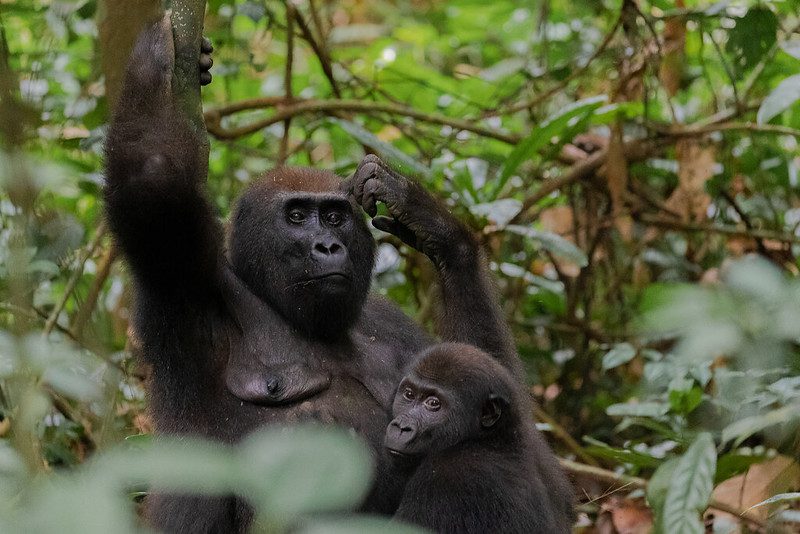Facts About the Eastern Lowland Gorillas
Facts About the Eastern Lowland Gorillas: The largest living mammal, gorillas inhabit lowland regions, woodlands, and marshes in East, Central, and Western Africa. In addition, there are two subspecies of gorillas: the Eastern gorilla and the Western gorilla. To learn more about the eastern lowland gorillas, keep reading this page.
Whereas the Eastern gorillas are separated into Mountain gorillas and Eastern lowland gorillas, the Western gorillas are separated into Western lowland gorillas and Cross River gorillas.
There are two subspecies of Eastern gorillas: the mountain gorilla, which is found in the Virunga Mountains, and the Eastern lowland gorilla, which is found exclusively in Kahuzi Biega National Park. Equatorial Guinea, Gabon, Congo Brazzaville, Angola, the Central African Republic, Cameroon, and the Democratic Republic of the Congo are among the countries where Western lowland gorillas are most frequently found in zoos.
Only three nations are home to mountain gorillas: Rwanda, Uganda, and the Democratic Republic of the Congo. Furthermore, Congo Brazzaville’s Odzala National Park has the largest density of western lowland gorillas.
However, the majority of them inhabit isolated environments, making it challenging for researchers to determine their precise population size. According to current estimates, there are around 130,000 people living in the western lowlands, an isolated swampy area in the northern Congo. Researchers and conservationists have both been captivated by Brazzaville.
characteristics of the gorilla species;
The most tranquil and serene apes are mountain and eastern lowland gorillas. Only when threatened may they charge back.
Gorillas never act aggressively unless provoked. Sometimes, but not often, the males will fight over the ladies.
Gorillas use body language or sounds to communicate.
They groom, climb, swing on treetops, and playfully chase one other throughout the day.
They consume fruits, leaves, stems, and shrubs.
Compared to Eastern lowland groups, which typically consist of 20–30 people, mountain gorilla groups typically have more individuals.
A dominant silverback leads the groupings in which both subspecies reside. Before replacing the dominant silverback, other males in the group may decide to live as bachelors.
When females attain the age, they typically join other groups.
The majority of a gorilla’s life is on the ground. Both species use leaves, shrubs, and tree branches to construct their nests on the ground, where they spend the night. Females and juveniles may construct their nests atop trees.
Facts about Eastern Lowland Gorillas
The International Union for Conservation of Nature’s “IUCN” list of species that require particular protection includes the critically endangered Eastern Lowland gorilla. The reason for this is that they frequently reside in areas that are unstable, prone to poaching, or where rebel groups are engaged in combat.
Humans who are engaged in logging, mining, building farmlands, grazing land expansion, and new communities are ruining their environments. Their numbers have decreased as a result of illnesses like Ebola. For the Eastern lowland gorillas, however, there is yet hope.
As their numbers have increased, experts and conservationists have been working nonstop to make sure they survive. One of the groups that has taken the lead in generating money and awareness of the need for more thorough monitoring and conservation of lowland gorillas is the World Wildlife Fund, or “WWF.” Be aware that there are numerous differences between mountain and Eastern lowland gorillas.
distinctions between mountain and eastern lowland gorillas;
The male silver back of the eastern lowland gorilla’s back may extend to the thighs and lower torso, and their coats are browner.
The eastern lowland gorillas are smaller than the mountain gorillas, but their skulls are larger and wider.
Compared to mountain gorillas, eastern lowland gorillas are more mobile. This is due to the fact that their habitats are widely dispersed.
Males are typically much larger than females in both subspecies.
More intelligent, Eastern Lowland Gorillas have been observed in the field use a range of tools.
Some of the lowland gorillas have been observed by researchers assessing the depth of rivers and wetlands before deciding to cross to the opposite end. in a prison.
Gorillas in the eastern lowlands have demonstrated the capacity to acquire sign language. In contrast to those found in the wild, they could acquire new routines and behaviors.
Gorilla Trekking in the Eastern Lowlands of Kahuzi Biega National Park
About 500 gorillas call Kahuzi-Biega National Park home, and it is the only safari destination where one can trek Eastern Lowland gorillas. Three of the approximately nine gorilla families are habituated and available for the activity.
The park is located south of Lake Kivu and close to Bukavu in the eastern region of the Democratic Republic of the Congo. These giant apes have exceptional habitat thanks to the topography of Kahuzi-Biega National Park.
The Tshivanga Visitor Center, just outside the park entrance, is where the gorilla trekking experience in Kahuzi-Biega National Park begins with a briefing. While providing visitors with information about the gorilla families and their habitat, the park ranger guide will walk you through the guidelines for lowland gorilla trekking.
Following the briefing, park rangers will guide the guests along tracking routes to locate the designated gorilla troop. After assigning the gorilla family, you will have an hour to watch their habits, eat, and play while shooting special pictures and movies.



